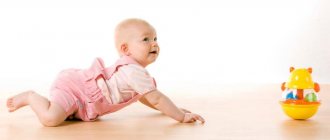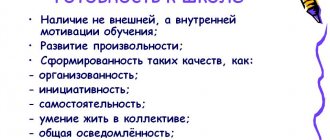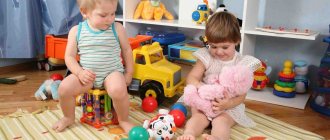Main features of infancy
During the first year of life, children experience various physical changes:
- motor skills are formed (general, fine);
- coordination of movements is normalized;
- the mechanism of muscle tone is improved;
- vision and hearing develop.
By the end of the period, speech and walking are actively developing.
The psychological features of the development of infants include the processes of memory formation and mental function. Some of the conditioned reflexes can be attributed to the manifestation of facial functions. For example, when a baby stops crying when a caring adult appears. The next stage is recognizing objects. After four months, babies begin to perceive melodic sounds. Then the child distinguishes mother from strangers. The older he gets, the wider the range of memorized objects and associations. Closer to one year (9–11 months), at the request of their parents, babies bring or point to a certain thing or toy. By the end of infancy, associative memory develops.
Mental activity is expressed in the desire to achieve a goal at any cost. This is typical for late infancy. Closer to 9 months, babies are able to solve simple spatial problems. This can be observed in the example of a sorter, when a baby selects the right hole for an element of a certain shape. Thinking during this period is flexible, children easily generalize the experience gained and are able to use it in similar situations.
Mental development in the first year of life is considered multichannel. Individual, social, and behavioral characteristics are formed. The participation of an adult and a developmental environment provide the child with full development.
According to Vygotsky, the mental life of an infant is characterized by an absolute lack of differentiation of mental functions. Primitive experiences and instinctive consciousness are formed under the influence of brightly colored emotional processes.
Early age (from 1 year to 3 years)
The next stage - psychological separation from the mother - begins in early childhood. This is due to the fact that the child not only develops new physical capabilities, but also intensively develops psychological functions, and by the end of the period, the initial foundations (rudiments) of self-awareness appear.
Development of mental functions. Sensitive period for speech acquisition.
Speech. By the age of 3, a child’s speech acquires a substantive meaning and, in connection with this, substantive generalizations appear. Active and passive vocabulary is growing rapidly. By the age of 3, a child understands almost everything. Speaks 1000 – 1500 words.
Perception. At an early age, other mental functions develop - perception, thinking, memory, attention. Perception dominates.
This means a certain dependence of other mental processes on it. This manifests itself - young children are maximally connected to the current situation. Their behavior is spontaneous and impulsive; nothing that lies outside the visual situation attracts them.
Until the age of 2, a child cannot act at all without relying on perception.
Elementary forms of imagination. A small child is not capable of inventing something or lying.
Perception is affectively colored - impulsive behavior. Observed objects really “attract” the child, causing him to have a strong emotional reaction. The affective nature of perception leads to sensorimotor unity. The child sees a thing, he is attracted to it, and thanks to this, impulsive behavior begins to unfold - to get it, to do something with it.
Memory. Basically, this is recognition, there is no reliance on past experience.
Actions and thinking. Thinking in this age period is usually called visual-effective. It is based on the perceptions and actions carried out by the child. And although at approximately 2 years of age the child develops an internal plan of action, throughout early childhood objective activity remains an important basis and source of intellectual development. In joint activities with an adult, the child learns ways of acting with a variety of objects.
Thinking initially manifests itself in the very process of practical activity, therefore, according to domestic psychologists, it lags behind it in terms of the general level of development and the composition of operations. The objective actions themselves are also improved. The mastered actions are transferred to other conditions.
The leading activity during this period is object-manipulative. The child does not play, but manipulates objects, including toys, focusing on the actions with them. However, at the end of early childhood, play with a plot still appears in its original forms. This is the so-called director's game, in which the objects used by the child are endowed with playful meaning. For the development of play, the appearance of symbolic or substitutive actions is important.
Emotional development. The development of mental functions is inseparable from the development of the emotional-need sphere of the child. The dominant perception at an early age is affectively colored. The child reacts emotionally only to what he directly perceives.
The child’s desires are unstable and quickly passing, he cannot control and restrain them; They are limited only by punishments and rewards from adults. All desires have equal strength: in early childhood there is no subordination of motives. The child still cannot choose or settle on one thing - he is not able to make a decision.
The development of the emotional-need sphere depends on the nature of the child’s communication with adults and peers.
In communication with close adults who help the child explore the world of “adult” objects, the motives of cooperation predominate, although purely emotional communication, which is necessary at all age stages, also remains.
A young child, when communicating with children, always proceeds from his own desires, completely disregarding the desires of others. Egocentrism. Doesn't know how to empathize. Early childhood is characterized by vivid emotional reactions associated with the child’s immediate desires.
At the end of this period, when approaching the 3-year crisis, affective reactions to the difficulties faced by the child are observed. A young child is easily distracted. If he is really upset, it is enough for an adult to show him a favorite or a new toy, offer to do something interesting with him - and the child, for whom one desire is easily replaced by another, instantly switches and is happy to do a new activity.
The development of the child’s emotional-need sphere is closely related to the emerging self-awareness at this time. At about 2 years old, the child begins to recognize himself in the mirror. Self-recognition is the simplest, primary form of self-awareness. The consciousness of “I”, “I am good”, “I myself” and the emergence of personal actions propel the child to a new level of development. The transition period begins - a crisis of 3 years.
Characteristics of infancy in different psychological schools
The study of the formation of mental processes in children made it possible to understand the principles and patterns of the development of thinking and perception of the child’s personality. Many concepts and studies formed the basis of modern methods of early development and education.
Cultural-historical theory
In Vygotsky's theory, the infant is viewed as a maximally social being. This is due to his helplessness - without the assistance of his parents, he cannot interact with the world. The basis of mental life in the first year of life is interaction with the mother and other relatives. At the same time, the baby is an active participant in this interaction. It influences the behavior of the mother and other adults in his environment.
Another adherent of cultural-historical theory, Elkonin, proposed considering the baby and his mental development in the “child in society” system. Within its framework, the environment and the baby are not considered separately and in isolation, they are perceived as a single system.
Psychoanalysis
The founder of the theory, Freud, endowed infants with innate drives (instincts). It is their satisfaction, in his opinion, that becomes the main driving stimulus for the behavior of the infant, and subsequently of the adult.
The theory identifies several stages of development that occur sequentially. Children from birth to one and a half years are in the oral stage. This is due to the fact that they get the greatest pleasure from feeding and sucking the breast. Thus, Freud identifies the pleasure center in the mouth.
Erickson complements the theory by considering the entire complex of communication with the mother or an adult replacing her. Kindness, care, and responsiveness to the baby’s needs build his trust in the world. The lack of psychological contact leads to the opposite, wary attitude. Both scenarios affect the future life of the child, and even the adult.
Psychogenetics
Considers mental development and behavior from the point of view of the influence of heredity and environment. One of the leading authors of Piaget's theory assigned the main role in the formation of the psyche to the intellect. The speed and completeness of adaptation to the environment depends on its development. The theory gave the world a twin method for analyzing the influence of genetics and environment on development. Psychogenetics does not take into account personal motives, needs, and feelings.
Behaviorism
The theory considers behavior as an objective phenomenon of mental development. It is formed through the so-called social learning. It is determined by the environment, which is the main source of human mental development. Only behavior is studied, without taking into account emotions and intelligence. The founder of the theory, Watson, placed mental care for the baby at the forefront. He defined it as more important than physical. After all, it is he who shapes character and behavior. By mental development he understood the acquisition of new connections between stimuli and reactions to them, skills, and forms of interaction with the outside world.
Gestalt psychology
The theory believes that the baby's psyche is formed as gestalts mature. They form the constancy and meaningfulness of certain mental processes. Thus, for the first months of life, babies have only a vague, blurry image of an adult caring for them. Closer to six months, a more complete and distinct portrait is formed.
Structure and dynamics of leading activity in infancy
The leading activity of the first half of infancy is emotional communication with adults. From the age of three months, the baby looks for it and attracts the mother’s attention.
In the second half, the child becomes more mobile. He can roll over on his own, learns to grab, sit, and crawl. He is increasingly focused on studying the world around him. Manipulation with objects closer to 9 months becomes the basis of his activity. He cannot yet use them for their intended purpose, but he finds his own use.
To move on to objective activities (using things for their intended purpose), he needs the help of adults. Changing the type of activity closer to the year means the end of the infancy period and the beginning of the early childhood stage.
Psychology of infancy and early childhood: structure and developmental features
We will help you write any paper on a similar topic.
- Essay
From 250 rub.
- Test
From 250 rub.
- Course work
From 700 rub.
Receive completed work or specialist advice on your educational project
Find out the cost
INFANT AGE (2 months – 1 year)
The leading type of activity is direct emotional communication with an adult. Dependence on an adult is comprehensive. For example, cognitive: all cognitive processes are realized in relationships with the mother and with the help of her.
Neoplasms of age
1. By the age of one year, the child pronounces the first words (the structure of the speech act is formed);
2. Masters voluntary actions with objects of the surrounding world (structure of objective action).
Speech
Until one year of age, a child’s speech is passive: he understands intonation and frequently repeated constructions, but does not speak himself. But it is precisely at this time that the foundations of speech skills are laid. Children themselves lay these foundations, striving to establish contact with adults through crying, humming, cooing, babbling, gestures, and then their first words.
Autonomous speech takes about a year to form and serves as a transitional phase between passive and active speech. Sometimes autonomous speech is called children's jargon. In form it is communication. In terms of content - an emotional and direct connection with adults and the situation.
Features of autonomous speech:
- does not coincide with the speech of adults articulatory and phonetically (“bi-bi”), as well as in meaning (multiple meanings of the same vocalizations);
- communication is possible only with people initiated into the code of children's speech, and in a specific situation;
- the connection between words is peculiar: speech resembles a series of exclamations uttered in passion.
The beginning and end of autonomous speech marks the beginning and end of the crisis of one year.
Active speech. Occurs by 1.6–2 years of age (in girls earlier than in boys). The vocabulary for 1 year is about 30. Questions “where?”, “how?” perform specific functions in the organization and self-regulation of behavior. The first words are action words with the aim of changing the communicative situation (“give!”). Although in most cases the first words are nouns in form, they are essentially verbs.
When teaching speech, adults should speak to children clearly and distinctly in order to impart correct speech skills to them. Show and name objects, tell stories. The process of language acquisition is more successful if parents help.
Subject activity
Object activity is associated with the development of movements in a child. There is a pattern in the sequence of movement development.
1. Moving eye. The phenomenon of “newborn eyes” is known - they can look in different directions. By the end of the second month, these movements are refined, and the child is able to visually concentrate on an object. By the third month, eye movements are developed almost the same as in an adult, and binocular vision is formed.
2. Expressive movements (animation complex - see above).
3. Moving in space is a prerequisite for mastering activities with objects. The child consistently learns to roll over, raise his head, sit down, crawl, stand on his feet, and take his first steps. All this - at different times, and the timing is influenced by the parents' strategy (see below). Mastering each new movement opens up new boundaries of space for the child.
4. Crawling. Sometimes skips this stage.
5. Grasping. By the end of the first half of the year, this movement turns from accidental grabbing of the toy into a deliberate one.
6. Manipulation of an object. It differs from “real” actions in that the item is not used for its intended purpose.
7. Pointing gesture.
8. Arbitrariness of movements and gestures, controllability. This is the basis for new formation – objective activity.
As soon as a child learns to walk, the boundaries of the accessible world expand. Consequently, the rivers are freed and the child gets the opportunity to act with things.
Object activity is activity with objects according to their purpose. But the method of action is not “written” on objects; it cannot be discovered by the child independently. The child must learn this from adults. Gradually the child masters human action.
He masters:
- purpose of the item;
- methods of dealing with objects;
- technique of performing actions.
Toys are of great importance in mastering objective activities. Their purpose is in accordance with the leading activities (first - in indicative behavior, then - in communication with adults; then - in objective activity.
Mental development
According to Piaget, a child under one year of age is in the 1st period of mental development - sensorimotor. Children at this time have not yet mastered language and they do not have mental images for words. Their knowledge about people and surrounding objects is based on information received from their own senses and random movements. The sensorimotor period goes through 6 stages, 4 of which are up to a year.
1. Reflex exercise. Children “practice” all the skills they have at a given stage of development. These are unconditioned reflexes: sucking, grasping, crying. In addition, newborns can also look and listen.
2. Primary circular reactions (1 – 4 months of life). The child begins to adapt to his environment using accommodation (adjusting old patterns to new information).
3. Secondary circular reactions (4 – 8 months). Children voluntarily repeat those forms of behavior that give them pleasure; They develop the ability to perceive object permanence. This quality is associated with the appearance of the first fears at 7-8 months (fear of the “stranger”), and the perception of the permanence of objects forms the basis of attachment to people significant to the child.
4. Coordination of secondary schemes (8 – 12 months). There is further development of all the mentioned abilities of the child. Babies show the first signs of the ability to anticipate events (for example, they cry at the sight of iodine).
Basic need of age
The basic need of age is the need for safety and security. She must be fundamentally satisfied. This is the main function of an adult. If a child feels safe, then he is open to the world around him, he will trust it and explore it more boldly. If not, it limits interaction with the world to a closed situation. E. Erikson says that at a young age a person develops a feeling of trust or distrust in the world around him (people, things, phenomena), which the person will carry throughout his life. A feeling of alienation occurs when there is a lack of attention, love, affection, or when children are abused.
At the same age, a feeling of attachment is formed.
There are 3 phases in the process of forming a child's attachment: (1) the baby seeks intimacy with any person; (2) learns to distinguish familiar people from unfamiliar ones; (3) a feeling of attachment arises for those people who are especially significant for the child. Social communication and a feeling of comfort contribute to the formation of children's attachment more than timely feeding, as they give this feeling a purely human character.
The second half of the stable period is characterized by an expansion of the boundaries of communication. The unity of the adult and the child is broken, two appear. Consequently, the social situation changes. Its change is the essence of the crisis of one year.
CRISIS OF ONE YEAR
New formation of crisis – autonomous speech
(see above).
The one-year crisis is characterized by the development of speech action. The baby's body was regulated by a biological system associated with biorhythms. Now she came into conflict with a verbal situation based on self-order or orders from adults. Thus, a child aged about one year finds himself without a system at all that allows him to reliably navigate the world around him. Biological rhythms are greatly deformed, and speech rhythms are not so formed that the child can freely control his behavior.
The crisis is characterized by a general regression of the child’s activity, a kind of reverse development. Emotionally manifests itself in affectivity. Emotions are primitive. In this case, various violations are observed:
- disruption of all biorhythmic processes (sleep - wakefulness);
- violation of the satisfaction of all vital needs (for example, hunger);
- emotional anomalies (sullenness, tearfulness, touchiness).
The crisis is not an acute one.
EARLY CHILDHOOD (1 – 3 years)
At this age, the lines of mental development of boys and girls separate. They have different types of leading activities. In boys, on the basis of object-based activity, object-tool skills
.
In girls, based on speech activity - communicative
.
Object-tool activity includes manipulation with human objects, the rudiments of design, as a result of which abstract, abstract thinking is better developed in men.
Communicative activity involves mastering the logic of human relationships. Most women have more developed social thinking than men, the sphere of manifestation of which is communication between people. Women have finer intuition, tact, and are more prone to empathy.
Gender differences in the behavior of children are due not so much to biological and physiological reasons as to the nature of their social communication. The orientation of boys and girls to different types of activities is socially determined, due to cultural patterns. In fact, there are more similarities than differences between male and female babies. The differences appear later. Basically, boys and girls develop in parallel and go through the same stages.
Thus, by the age of three, children of both sexes develop the following age-related neoplasms:
: the beginnings of self-awareness, development of self-concept, self-esteem. The child does 90% of the work of acquiring language. In three years, a person goes through half the path of his mental development.
First ideas about yourself
occur in a child by the age of one year.
These are ideas about parts of his body, but the baby cannot yet generalize them. With special training by adults, by the age of one and a half years, a child can recognize himself in the mirror, master the identity of the reflection and his appearance.
By the age of 3, there is a new stage of self-identification: with the help of a mirror, the child gets the opportunity to form his idea of his present self.
The child is interested in all the ways of confirming his Self. By spiritualizing individual parts of the body, in play he learns the will over himself.
A three-year-old child is interested in everything connected with him, for example, a shadow. Begins to use the pronoun “I”, learns his name and gender. Identification with one's own name is expressed by a special interest in people who share the same name.
Gender identification.
By the age of 3, a child already knows whether he is a boy or a girl. Children gain such knowledge from observing the behavior of their parents and older brothers and sisters. This allows the child to understand what forms of behavior in accordance with his gender are expected from him by others.
A child’s understanding of a particular gender occurs in the first 2-3 years of life, and the presence of a father is extremely important. For boys, the loss of a father after 4 years of age has little effect on the acquisition of social roles. The consequences of fatherlessness for girls begin to be felt in adolescence, when many of them have difficulty adapting to the female role when communicating with members of the other sex.
The emergence of self-awareness.
By the age of three, a child shows the beginnings of self-awareness and develops a desire for recognition from adults. By positively assessing certain actions, adults make them attractive in the eyes of children and awaken in children the desire to earn praise and recognition.
Language acquisition.
The vocabulary of children aged 1.5 years usually contains about 10 words, at 1.8 – 50 words, at 2 years – approximately 200. By the age of three, the vocabulary is already 900 – 1000 words. A direct relationship has been established between the quality of language stimulation in the home environment and the development of a child’s speech at 3 years of age.
The critical period in the development of children's speech is, according to researchers, the age from 10 months to 1.5 years. It is at this time that calm and educational games are needed and stress is undesirable.
When learning a language, children of all nations go through the stages of one-part, two-part and complete sentences. All languages existing on earth have rules of grammar, syntax, and semantics. At first, children generalize the rules to the extreme.
Mental development.
The main incentive for improving mental activity in “walking” children is their sensory-motor activity. Children 1-2 years old are in the first (sensorimotor) period of mental development, which Piaget divided into 6 stages. The child goes through 4 of them before one year (see above).
Stage 5
– tertiary circular reactions (1 – 1.5 years) – experimentation with objects. The purpose of experiments is in themselves: kids love to observe how objects behave in new situations. Reflexive behavior is replaced by truly mental activity: the child is looking for new ways to interact with previously unknown objects.
Stage 6
(1.5 – 2 years). The emergence of symbolic thinking, that is, the ability to perceive them at one time or another based on psychological images imprinted in the brain (symbols of objects). Now the child can perform operations not with real, but with ideal objects. The child becomes able to solve simple problems in his head, without resorting to trial and error. Physical actions contribute to the successful functioning of thinking.
The perception of the external world at this stage of mental development is characterized by egocentrism
. A child of 1.5 - 2 years old is already aware of his isolation, separation from other people and objects, and also understands that some events can happen regardless of their desires. However, he continues to believe that everyone sees the world the same way as he does. Formula for baby perception: “I am The whole world revolves around me.”
Fears
Children aged 1 to 3 years have a greater range of fears than infants. This is explained by the fact that with the development of their perception abilities, as well as mental abilities, the scope of life experience expands, from which more and more new information is drawn. Noticing that some objects may disappear from their field of vision, children are afraid that they themselves may disappear. They may be wary of the water pipes in the bathroom and toilet, thinking that the water might carry them away. Masks, wigs, new glasses, a doll without an arm, a slowly deflating balloon - all this can cause fear. Some children may have a fear of animals or moving cars, and many are afraid to sleep alone.
Usually, fears disappear over time as the child masters more subtle ways of thinking. Excessive irritability, intolerance, and anger of parents can only aggravate children's fears and contribute to the child's feeling of rejection. Excessive parental care also does not relieve the child of fear. A more effective way is to gradually accustom them to communicate with objects that cause fear, as well as a clear example.
Basic need of age
If in infancy the need for security was saturated, then the need for love
. Children aged 1 to 3 years are still dependent on their parents; they constantly want to feel the physical closeness of their father and mother. The leading role in satisfying basic needs is given to the parent of the opposite sex. 3-4 years – formation of the Oedipus complex and the Electra complex. Tactile contact becomes important. The child masters the language of sensations. If the need is not satisfied, the person remains tactilely insensitive (for example, it is at this age that the formation of erogenous zones occurs).
CRISIS OF 3 YEARS
When approaching a crisis, there are clear cognitive symptoms:
- acute interest in one's image in the mirror;
- the child is puzzled by his appearance, interested in how he looks in the eyes of others. Girls have an interest in dressing up; boys begin to show concern for their efficiency, for example, in construction. They react sharply to failure.
The crisis of 3 years is considered to be acute. The child is uncontrollable and becomes angry. The behavior is almost impossible to correct. The period is difficult for both the adult and the child himself. The symptoms are called the seven-star crisis of 3 years
.
1. Negativism
- a reaction not to the content of the adults’ proposal, but to the fact that it comes from adults. The desire to do the opposite, even against one’s own desire.
2. Stubbornness
.
A child insists on something not because he wants, but because he
demanded it, he is bound by his original decision.
3. Obstinacy
. It is impersonal, directed against the norms of upbringing, the way of life that developed before the age of three.
4. Self-will
. Strives to do everything himself.
5. Protest-riot.
The child is in a state of war and conflict with others.
6. Symptom of devaluation
manifests itself in the fact that the child begins to swear, tease and call his parents names.
7. Despotism
. The child forces his parents to do everything he demands. In relation to younger sisters and brothers, despotism manifests itself as jealousy.
The crisis proceeds as a crisis of social relations and is associated with the formation of the child’s self-awareness. “I myself” appears
. The child learns the difference between “should” and “want”.
If the crisis proceeds sluggishly, this indicates a delay in the development of the affective and volitional sides of the personality. Children begin to develop a will, which E. Erikson called autonomy (independence, independence). Children no longer need adult supervision and strive to make their own choices. Feelings of shame and uncertainty instead of autonomy arise when parents limit the child’s expressions of independence, punish or ridicule any attempts at independence.
The child’s zone of proximal development consists of acquiring “I can”: he must learn to correlate his “want” with “should” and “cannot” and on this basis determine his “can”. The crisis drags on if the adult takes the position of “I want” (permissiveness) or “I can’t” (prohibitions). The child should be provided with an area of activity where he can demonstrate independence.
This area of activity is in the game. The game, with its special rules and norms that reflect social connections, serves for the child as a “safe island where he can develop and test his independence and independence” (E. Erikson).
Attention!
If you need help writing a paper, we recommend turning to professionals. More than 70,000 authors are ready to help you right now. Free adjustments and improvements. Find out the cost of your work.
Cost calculationGuaranteesReviews
Communication between infants and adults
The first year of life, the child is completely dependent on the adults around him. His basic need is a feeling of security. It is this feeling that makes the baby understand that everything is fine with him, there are no threats. If this need is fully satisfied, he is open to the world and ready for full contact with it.
In psychology, the concept of “mother-child dyad” or “Prime-we” was introduced for the stage of infancy. It determines the mental community of the baby and the adult caring for him. During this period, the child is not aware of himself, is unable not only to distinguish his Self, but also perceives his own limbs as foreign objects. Therefore, the adult becomes the center of interaction with the child and the child with the world.
The first half of the year is characterized by situational and personal communication between the baby and mother. It manifests itself as a revitalization complex that marks the end of the newborn crisis. It is characterized by focusing on the mother's face, a welcoming smile, and active movements that attract the attention of an adult. This is purely emotional communication. The mother’s kindness towards the baby during this period is the key to normal mental and cognitive development in the future.
The second half of the period is characterized by situational business communication. It lays the foundations for objective activity. The child enters this stage after he learns to grasp objects. In the process of contact with an adult, he uses not only facial expressions and sounds, but also gestures, postures, and various things. He can show, bring closer, remove, throw, demand any toy. Babies begin to feel the need for joint activities with their mother.
During this period, attachment formation occurs. It is the key to the child’s psychological health. There are three stages of its formation:
- The infant seeks contact and closeness with any adult in sight.
- Begins to distinguish “us” from “strangers”.
- Attachment to the most significant adults is formed.
It is full communication with the baby that allows him to successfully develop physically, mentally, mentally.
Infancy
The newborn is a transitional stage.
Adaptation with the help of hereditarily fixed mechanisms - the system of food reflexes (food concentration). Unconditioned reflexes – protective and indicative. By the end of the first month, the first conditioned reflexes appear (the baby begins to respond to the feeding position), but in general they develop later.
Mental life. The brain of a newborn continues to develop, it is not fully formed, therefore mental life is connected mainly with the subcortical centers, as well as with an insufficiently mature cortex. The sensations of a newborn are undifferentiated and inextricably fused with emotions, which made it possible for L.S. Vygotsky speaks of “sensory emotional states or emotionally emphasized states of sensations.”
Important events are the emergence of auditory (2–3 weeks) and visual (3–5 weeks) concentration.
Specific social situation of development - helplessness, biological connection with the mother, dependence on an adult.
At about 1 month - the “revitalization complex” - a violent emotional reaction to the appearance of the mother, including a smile, which means the first social need - the need for communication. This marks a new psychological period. Infancy proper begins.
Infancy
Cognitive development of the child: perception - by 4 months. not just sees, but already looks, actively reacts to what he sees, moves.
Perceives the shape of objects, identifies the contour and their other elements, and is able to navigate many parameters of objects (movements, contrasts, etc.).
React to color.
Spatial perception develops, in particular depth perception.
For development, it is necessary to satisfy his need for new impressions, trying to ensure that the environment around him is not monotonous and uninteresting. The baby has a holistic picture of the world.
Movement and actions. Hand movements directed towards an object and feeling an object appear at about 4 months of life.
At 5 – 6 months, an object is grabbed, which requires complex hand-eye coordination – the first purposeful action. Chains of identical, repeating actions unfold, which J. Piaget called circular reactions.
After 7 months, “correlating” actions occur: putting small objects into large ones, opening and closing the lids of boxes.
After 10 months, the first functional actions appear, but they are not yet objective (imitation of adults).
Perception and action make it possible to judge the initial forms of visual-effective thinking.
The cognitive tasks that the child is able to solve become more complex, first only in terms of perception, then using motor activity.
Memory. Recognition comes first. A 4-month-old baby distinguishes a familiar face from an unfamiliar one.
After 8 months, reproduction appears - restoration of the image in memory.
Emotional development. In the first 3 - 4 months. Various emotional states appear: surprise in response to the unexpected (inhibition of movements, decreased heart rate), anxiety in response to physical discomfort (increased movements, increased heart rate, squinting of the eyes, crying), relaxation when a need is satisfied. After 3–4 months, he smiles at acquaintances, but is somewhat lost at the sight of an unfamiliar adult. At 7–8 months, anxiety when strangers appear increases sharply. Around the same time, between 7 and 11 months, the so-called “fear of separation” appears. By the end of 1 year, he strives not only for emotional contacts, but also for joint actions.
Speech. In the first half of the year, speech hearing is formed. Booming. In the second half of the year - babbling, usually combined with expressive gestures. By the end of 1 year, the child understands 10–20 words spoken by adults, and he himself pronounces one or several of his first words, similar in sound to the words of adult speech. With the appearance of the first words, a new stage in the child’s mental development begins.
Main neoplasms of infancy
The main acquisitions of infancy are the ability to walk and the first consciously spoken words. The ability to move without the help of an adult takes the child to a new stage of cognitive activity. In psychology, he is considered as a subject capable of performing independent actions. This is due to the emergence of motivating needs. They mean emotionally charged images of objects that appear in the baby’s memory, with which some of the needs are associated. That is, although the child will show or grab his sippy cup or cup when drinking.
By the end of infancy, children master voluntary actions with objects. From manipulation they gradually move to substantive activity.
But for this successful transition you need the help of an adult. Only by imitating their parents will the child understand how to use this or that thing for its intended purpose.
By one year the child will have mastered:
- the purpose of simple objects (spoon, plate, chair);
- ways of acting with them (eating with a spoon, sitting on a chair);
- technique of performing the action (you need to take a spoon in your hand and try to scoop up food).
A child around one year of age becomes emotionally separated from the mother or other significant adult. Thanks to the emergence of speech, the social situation changes and new opportunities for communication appear.
A new development in children aged about one year is the transition from passive speech through the autonomous to active phase. If previously the child only understood intonations and part of the words, now he is developing his own “bird” language. He is understandable only to the closest people who come into contact with him on a daily basis.
Autonomous speech is characterized by:
- The ambiguity of the same words depends a lot on the emotional coloring and the situation.
- The discrepancy with normal speech is not phonetic or articulatory.
- It is difficult to find a connection between spoken words. The phrases are more like emotionally charged exclamations.
Many psychologists associate the appearance of autonomous speech with the beginning of the crisis of the first year of life. And the transition from it to the usual one is with its completion.
Newborn crisis
The process of birth is a difficult, turning point in the life of a child. Psychologists call this period the neonatal crisis.
Causes of the neonatal crisis: - Physiological (being born, the child is physically separated from the mother. He finds himself in completely different conditions: cold, bright light, an air environment that requires a different type of breathing, the need to change the type of nutrition). — Psychological (the psyche of a newborn child is a set of innate unconditioned reflexes that help the child in the first hours of his life). What unconditioned reflexes does a newborn have? These are, first of all, breathing and sucking reflexes, protective and orientation reflexes. Some reflexes are atavistic (“catching”) - they are received from animal ancestors, are useless for the child and soon disappear. The child sleeps most of the time.
Crisis of one year
The second transitional moment in the development of the child’s psyche. The basis of the crisis is the conflict between the skills he has acquired (walking, manipulating objects), the desire to show independence and the restrictions imposed by adults. On the one hand, he wants to do everything himself, but they don’t allow him, on the other hand, he is just developing his speech and fully communicating, he cannot defend his rights, and he cannot do without the help of an adult.
The crisis is characterized by:
- violation of sleep and eating patterns;
- mood swings, bright outbursts of emotions;
- negative reaction to any ban;
- increased need to be near a significant adult.
During this period, it is important for parents to develop a general strategy of behavior and correctly set personal boundaries and prohibitions. It is important not to punish the baby, since he still won’t understand the reason, not to scream, not to scold him.









